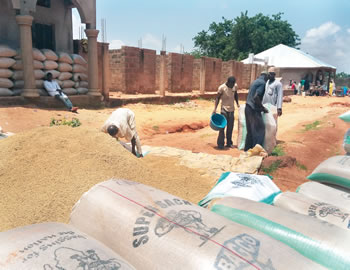Despite the February 2015 announcement that Nigeria’s local farmers would add about 2.9 million metric tonnes of rice to Nigeria’s rice stock from the 2014 season, the country was still losing N1 billion daily to rice imports, costing the country N360 billion annually; in addition to over N1.3 trillion lost to import waivers between years 2011 and 2014, according to the federal government. To plug this drainage in national purse, the federal government, through the Nigeria Customs Service (NCS), reintroduced the ban on rice imports through its land borders, in 2016, in an effort to boost local rice production in Nigeria. Prior to the ban, however, the Central Bank of Nigeria (CBN) in November 2015, rolled out a N40 billion Anchor Borrowers Programme (ABP) aimed at empowering at least 600,000 farmers to increase capacity utilisation in the agro-allied industry from the current levels of less than 50 per cent to at least 70 per cent by 2020. Nine months after the ABP launch, RUTH OLUROUNBI was in Kebbi State to investigate if the programme could help save Nigeria from imminent food crisis and if the country could indeed feed itself by 2020. Her report:
NIGERIA’S agriculture journey to food security has been on a chequered one at best. In the 1960s, Nigeria’s economy was dominated by exports and commercial activities, with agricultural sector being the mainstay of the economy, accounting for over 65 per cent of the country’s Gross Domestic Product (GDP) and about 70 per cent of its total export.
In fact, records from the Nigerian Export Promotion Council (NEPC) and the National Bureau of Statistics (NBS) show that agriculture earned foreign exchange with which Nigeria funded imports of raw material and capital goods. As historians have it, the 1960s was the period in Nigeria’s history when farmers from across the country produced crops in which their respective regions had comparative advantage.
Economic historians recall that Nigeria’s major exports of agricultural produce and minerals were shipped to the more industrialised countries, and in the comity of nations, Nigeria was a respected country which empowered local manufacturers to produce goods that were being imported, through the Import Substitution Industrialisation (ISI) strategy.
According to those who lived during the agriculture era, Nigeria was on its way to becoming a developed country. “There were jobs, people had enough money to spend and save; people were fed and were happy. The farmers were the rich people back then. If you took a trip across the vast lands of Nigeria, you’d be amazed at Nigeria’s abundance in cocoa, cassava, yam, groundnut, oil palm, maize or rice; Nigeria had it in abundance,” a 90-year-old man, who had farmed in the 60s recalled.
Then came the oil boom of the 1970s.
Depending primarily on the global oil market boom, agriculture as the mainstay of the Nigerian economy was replaced with oil. As Nigeria recorded high commercial success in the oil market, the farmer population, thousands of whom were lured into the urban lives, became hugely depleted and the farms that hitherto produced groundnuts, yams, cassava and rice became largely deserted.
But with economic realities in Nigeria – the oil on which it depended on is no longer bringing in the money – and the country is forced to retrace its steps to its abandoned first love, agriculture. Except that now, the challenges left to accumulate, is now staring at smallholder farmers which make a larger percentage of the farming population, business owners and well as the government, in the face.
Lack of finances to smallholder farmers and access to capacity development programme, as well as lack of access to research outcomes, gender inequality in the sector, poor management or outright lack of sustained value chain programmes, climate change, water scarcity and diminishing access to farm lands in some parts of the country, all serve to contributing to inevitable food insecurity in the country.
As food security in Nigeria is increasingly threatened by lack of foreign exchange with which many of Nigeria’s food items are imported, it was time to combat the desperate times with desperate measures – ban food imports especially rice from Nigeria and focus on local food production by empowering a large number of the country’s smallholders.
To encourage farmers to produce the otherwise imported food, the Central Bank of Nigeria (CBN) launched the Anchors Borrowers Programme.
The ABP
Rice is one of Nigeria’s stable foods and it depletes country’s GDP through imports. And despite previous efforts to boost local production in the agricultural sector, the import bill of the country continues to rise. In fact, Nigeria’s agricultural commodities and food import bill averaged over N1 trillion within a period of two years, according to CBN. Data show that food products such as wheat, sugar, milk, rice and fish accounted for N901 billion or 93.5 per cent and N788 billion or 88.71 per cent of this total in 2013 and 2014, respectively, excluding the figures lost to the activities of smugglers; not to mention the fact that import bill of rice and wheat was estimated at N428 billion and N307 billion in 2013 and 2014, respectively. According to official record, rice imports alone cost the country N360 billion and another N1.3 trillion in import waivers between 2011 and 2014.
In an attempt to stem the tide, a new initiative the Anchor Borrowers Programme (ABP), targeted at local farmers, especially the small scale farmers across the country, was developed with the hopes that the problem of food insecurity could be solved and the country may once again, become an exporter of agricultural commodities it once was, many stakeholders in the agriculture sector believe.
The ABP is a build up on several interventionists programmes such as the 1977 Agricultural Credit Guarantee Scheme (ACGS) aimed at helping farmers that have little or no collateral secure loans from Deposit Money Banks; the Commercial Agricultural Credit Scheme (CACS), the Nigeria Incentive-Based Risk Sharing System for Agricultural Lending (NIRSAL) and the Agricultural Credit Support Scheme (ACSS), designed to increase the confidence of DMBs in agricultural lending by reducing their risk exposures, among others.
But will the programme truly rescue the nation from impending food crisis? Opinions vary.
By creating the programme, the CBN governor, Godwin Emefiele, says the bank seeks to build capacity of banks, farmers and agricultural entrepreneurs, reduce commodity importation and conserve external reserves, as well as reduce the level of poverty among small holder farmers; and “more important, seeks to create jobs, assist rural small-holder farmers to grow from subsistence to commercial production levels, and facilitate the emergence of a new generation of farmers/entrepreneurs.”
The N40 billion programme, earmarked out of the N220 billion Micro, Small and Medium Enterprise Development Fund, would support the out-growers with single-digit loans. Designed such that major stakeholders in the agricultural value chain would work with financial institutions, including the insurance industry and CBN, to create the linkages required to sustainably ramp up production; the programme aims to train the farmers, extension workers and banks with customised value-chain finance modules for banks and an “agribusiness” training protocol for farmers that is consistent with the aspiration of the ABP. The the apex bank expects to mitigate risks through the identification and selection of smallholder farmers, the grouping of out-growers into viable cooperatives/clusters and the registration of the cooperatives, Emefiele explained.
The ABP put to the test in Kebbi State
Building on the success of a previous programme in Kebbi State known as KATASHI, Kebbi Agricultural Transformation and Self Help Initiative, launched by the then governor Muhammdu Aliru, in which more than 3,000 smallholder farmers were empowered to engage in food production, the current governor, Atiku Bagudu, reached out to the CBN and the federal government to try out the programme in his state, Sheu, the acting permanent secretary said in an interview.
Abubakar Bello, a member of the steering committee for the programme in the state, sitting in for the Commissioner for Agriculture and Natural Resources, Garba Muhammad Karaye, said an interview that “the immense benefits that was realised in rice production and other veritable crops [under the KATASHI programme] indicated that we can be able to exploit over 178,000 hectares of FADAMA land which this state is supplied with to meet the rice demand in the country.”
Banking on over 600,000 square kilometres of arable FADAMA land, and over 200,000 registered rice farmers in the state, the governor, who saw how only 3,000 farmers under the previous KATASHI programme had served to feed the state and its neighbours, the governor was able to convince the CBN to pilot the programme in the state, Sheu said.
How ABP made farmers “millionaires”
When Bello was asked to speak to economic impact on the farmers in the state, he said: “Most definitely, agriculture has never had it so good as we have this year.”
But it was Danjuma Bisi, who owns 55 hectares rice farm in Suru who said that never in 100 years have rice farmers in the state experienced such “financial prosperity as we are expecting right now.”
Yusuf Isa, state’s chairman, Rice Farmers Association of Nigeria (RIFAN), who conducted this reporter through massive rice farms in the area in Brinin Kebbi, said prior to the ABP, farmers struggled to make good returns on investments, as sales of a 75kg bag of rice sold for at the highest N5,500. “Today, however, same bags sells between N9,000 to N11,000, making thousands of rice farming in the state millionaires,” he said.
“Our people are now becoming millionaires! Prior to the ABP, our people could only harvest four tonnes of rice per hectare and they sell one bag for N5,500. But today, we have people harvesting up to seventy to eighty tonnes, selling at least N9,000 per bag. And you know that you can harvest rice at least twice, sometime three times in a year. If you multiply that, you see where I am going with is?” a very pleased Isa said.
Can the ABP help Nigeria feed itself by 2020?
Nigeria needs about 6.5 million metric tonnes of rice and currently, only 1.5 million metric tonnes is produced locally as at 2015 and a deficit of five million left to imports.
However, with the ABP, Kebbi, Sokoto as well as Zamfara farmers are confident that if the boarders remain closed to imports, Nigeria could, before 2020, produce enough food to feed itself and export to neighbouring African countries.
That is though, if the programme is sustained and is introduced to other states. “We may not reach 2020 in view of the results we’ve seen in Kebbi State, with the programme,” Abdulahi Idris Zuru, the General Manager, Labana Rice Mills, Brinin Kebbi said an interview in his office.
According to Zuru, since the programme was launched in Kebbi State in November 2015, rice production and processing in the state has increased in leaps and bounds. For instance, local rice farmers told me that rice production has increased by more than 300 per cent.
“Our farmers have really been producing in large quantity and our rice mill is processing 16 tonnes per hour, 320 tonnes per day. If you look at our capacity and what we have been able to produce in one and a half years, we have considerably contributed to the economic development of this country. We’ve been able to, within this short period, reach all parts of the country. As I am talking to you now, Kebbi produces one of the best varieties of yields in the country,” he said.
A call for sustainability and broader reach
The farmers, who spoke during independent interviews, said if the CBN-initiative is sustained, Nigeria could feed itself earlier than 2020 even. Isa, said through the programme, Brinin Kebbi currently expects to produce one million tonnes of rice in six months, as against less than 400,000 tonnes it previously produced.
Isa, explaining how Nigeria could meet the 2020 target, reasoned that if Kebbi could produce one million tonnes of rice in six months; and Sokoto, Zamfara and Nasarawa states could produce 1.5 million tonnes respectively, at the end of the harvest of the raining plantation, the country would edge closer to food security.
He explained that production yield is expected to “be a lot more during the dry seasons harvests and if we invest in limiting post-harvest loses, I can guaranteed you that Nigeria will not need to import rice and wheat again.
“Going forward, what we anticipate is the involvements of many more farmers for increase in land cultivation and of course, the increase in yields. But most important, there is going to be increase in value chain activities. Yes, as we continue to go forward, we expect that there will be investments now in mechanised farming, there will also be investment in agro-processing facilities and small scale investments of local entrepreneurs who are going to benefit in the programme will also increase.”
Muhammad Umar Bello, Programme Coordinator, Kebbi Agriculture Rural Development Authority and Sectary, Steering Committee on ABP, said “you can imagine how much potential in rice farming we have left untapped.” According to him, if other rice producing states join in, the country could significantly lower its import bill on rice in the country.
He said if sustained, more than 70,000 farmers who are currently under the state government could be multiplied to produce more rice in shorter period of time, Abubakar, who praised the programme, said, adding that currently, Kebbi farmers now produce more than seventy tonnes of rice per hectare, the first in the history of the state, according to him.
Farmers in the south-west Nigeria have also lend a voice to the clamour for self sustainability in fod production, calling for the ABP to reach the region as well as every state in the country.
Adeola Adekola, a farmer in Ekiti State said it was important that the ABP got to all the states, adding that through this, “we can effectively produce enough food to sustain the country and export abroad.”
The challenges before the programme
In spite of good reports the farmers were willing to share, many of them lamented that fund disbursements don’t get to them quickly enough. “Rice cultivation cycle is three months and sometimes, we would have finished cultivation and sometimes even harvested before the money get to us, a farmer, Usman Dubagari, a member of cooperative society in Suru said.
The farmers said they need the fund quicker than “one oga at the office thinks we need it,” adding this challenge is eating into their production.
Yakubu said “if they will not disburse funds quickly, how do we meet our production target. I want you to tell CBN and the federal government that this is frustrating us.”
A CBN representative who did not want to be named because he did not have authorisation to speak on the matter, confirmed the disbursement challenge, saying this brought on by lack of enough commercial banks partnering the CBN on the programme.
The funds are there, the representative said “but the fact that only one commercial bank is disbursing the funds through the Bank of Agriculture (BOA) throws a clog in the wheel.” According to the CBN representative, since money is given to farmers in trenches, “we have N160,000 out of N210,000 left to be disbursed to these farmers. Sometimes, they are only to get one or two trenches before the harvest occurs.”







